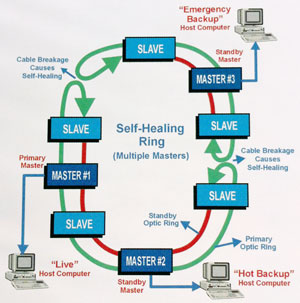1998 - Boston's "Big Dig" Project Uses TC's Fiber Optic Multiplexers
Most residents of Massachusetts and its neighboring states refer to the Boston Central Artery/Third Harbor Tunnel project as "The Big Dig." Often touted as America's largest construction project, it involves moving the city's main elevated highway underground.
A critical piece of this huge project is a communications network for Third Harbor Tunnel security that operates 24 hours a day to ensure traffic safety and efficiency. To maximize security network reliability, several precautions were taken. These precautions included specifying a primary and backup fiber optic cable with a self-healing ring topology and a fiber optic multiplexer that supports a "multiple master" self-healing ring topology.

TC2800 4/8/12-Channel Multi-Drop Fiber Optic Multiplexer
This "multiple-master" multiplexer requirement was fulfilled by the Model TC2800 from TC Communications of Irvine, California. It provided maximum reliability through its "multiple master" configuration. In this particular multiple-master configuration the TC2800 can maintain system integrity with up to six device or linkage faults. (See diagram on this page).
According to Kevin Driscoll of the Boston-based Norfolk Electric, a primary contractor for the project, the TC2800 multiplexer was chosen for the job because "it is significantly more reliable than the more common 'single' master topology."
Maximum Reliability
A multiple-master multiplexer is more reliable than a single master multiplexer because, in extreme situations where both rings are broken in two or more places, master units simultaneously poll the slave units, but through different half rings.
The self-healing ring topology consists of two data paths running in opposite directions. Under normal operation only the primary data path is used. Where there is a fault, the data path will turn around before it reaches the fault or failed unit and use the secondary data path to complete the link.

In this application, the multi-drop multiplexers form a sub-network that links the access control panels/intrusion detection system to the security computer and two main network computers. The system interfaces with card readers, keypad control units, automatic door latches and various alarms located near controlled entrances to buildings.
Three TC2800 Master multiplexers are linked to three main computers over separate data paths. One circuit is "live," one is a "hot" backup and the other is an emergency backup. The Master multiplexers poll five Slave units connected to the security network control panels.
The end result is that motorists traveling through the Third Harbor Tunnel have maximum protection with more reliable data paths.
In many traffic control applications, the TC2800 can be used as a low cost alternative to SONET or T1 Rings. High speed SONET networks are often overkill and it easily provides the desired network ring fault protection.
For example, the TC2800 can create a self-healing ring network for linking traffic intersections with multiple RS-232 drops for traffic lights, cross walks, camera PTZ, etc. A similar application uses the TC2800 to link PTZ, radar detectors, ram meters, weather stations, etc. along a stretch of highway.
The TC Communications Model TC2800 is transparent to all protocols and supports data rates up to 38.4 Kbps. Each unit provides two pairs of fiber interfaces and 4, 8 or 12 independent channels. Optical signals are regenerated at each drop. A hardened temperature version is available for extreme environments.